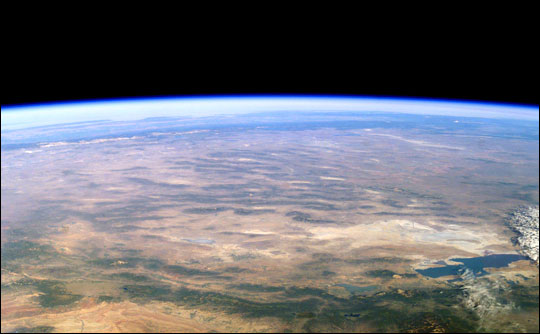

 | |||
One of my favorite things to do when I have time off is to just watch the world go by. Whenever I get a chance, I spend time just observing the planet below. It turns out you can see a lot more from up here than you might expect. First off, we aren’t as far away as some people think—our orbit is only about 240 miles above the surface of the Earth. While this is high enough to see that the Earth is round (believe me, it is), we are still just barely skimming the surface when you consider that the diameter of the Earth is over 8,000 miles. |
|||

So how much of the Earth can we see at one time? When you are standing on the ground, the horizon is a few miles away. When in a tall building, the horizon can be as far as about 40 miles. From the ISS, the distance to the horizon is over 1,000 miles. So from horizon to horizon, the section of the Earth you can see at any one time is a patch about 2,000 miles across, almost enough to see the entire United States at once. It isn’t exactly seeing the Earth like a big blue marble, it’s more like having your face up against a big blue beach ball. When I look out a window that faces straight down, it is actually pretty hard to see the horizon—you need to get your face very close to the window. So what you see out a window like that is a moving patch of ground (or water). From the time a place on the ground comes into view until when it disappears over the horizon is only a few minutes since we are traveling 300 miles per minute. |
Astronaut Ed Lu poses near the window in the Zvezda Service Module on the International Space Station. The Earth’s Horizon is visible through the window. In addition to the small windows on various modules throughout the station, the Destiny U.S. Laboratory has an optical quality window designed specifically for Earth Observations. ISS007-E-9227 (July 2, 2003) | ||
 | |||
When looking out a sideward facing window, you can see the horizon of the Earth against the black background of space. The horizon is distinctly curved. The edge of the Earth isn’t distinct but rather is smeared out due to the atmosphere. Here you can get a feel for how relatively thin the atmosphere is compared to the Earth as a whole. I can see that the width of the atmosphere on the horizon is about 1 degree in angular size, which is about the width of your index finger held out at arms length. For those of you who are farsighted, it is also about the height of a person when seen from about 100 yards away (the length of a football field). At a distance of 1,000 miles, that translates into a height of about 20 miles. There really isn’t a sharp boundary to the atmosphere, but it gets rapidly thinner the higher you go. Not many airplanes can fly higher than about 10 miles, and the highest mountains are only about 6 miles high. Above about 30 miles there is very little air to speak of, but at night you can see a faint glow from what little air there is at that height. |
This is the broadest view of Earth that an astronaut can get from the International Space Station. Ed took this view of the “Big Blue Beach Ball” using a wide angle lens while the Station was over the Pacific Ocean. In the foreground are the atolls of Tabitueua and Onotoa. ISS007-E-7304 (June 13, 2003, 16 mm lens) | ||
 | |||
Since we orbit at an altitude about 40 times higher than the tallest mountain, the surface of the Earth is pretty smooth from our perspective. A good way to imagine our view is to stand up and look down at your feet. Imagine that your eyes are where the International Space Station (ISS) is orbiting, and the floor is the surface of the Earth. The atmosphere would be about 6 inches high, and the height of the tallest mountain is less than 2 inches, or about the height of the tops of your feet. Almost all of the people below you would live in the first one quarter of an inch from the floor. The horizon of the Earth is a little over 20 feet away from where you are standing. If you are standing on top of Denver, then about 15 feet to one side you can see San Francisco, and about 15 feet to the other side you can see Chicago. At this same scale, the Earth that you are standing on would be a sphere with a diameter of about 160 feet. If you want to complete the effect, you can start walking and take a step about every 20 seconds. The data used in this study are available in one or more of NASA's Earth Science Data Centers. |
Ed took this photograph of the Earth’s horizon from a spacecraft position over Dodge City, Kansas, looking westward out the window. In the lower right is the Great Salt Lake. At the left side in the distance are the Sierra Nevada Mountains with elevations between 12,000 and 15,000 feet, and coastal California. ISS007-E-9986 (July 11, 2003, 50 mm lens) | ||